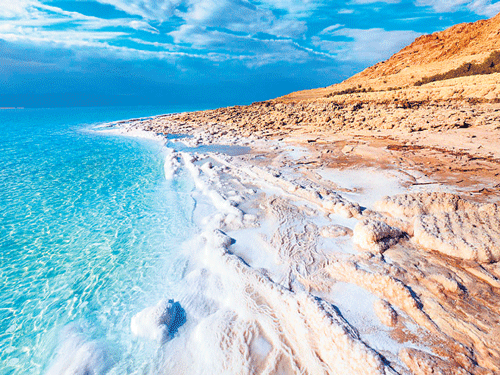
Whenever the name Dead Sea cropped up in school, a sense of awe writ large on every student’s face. This urged me to visit the salt lake on which people could float without any aid, and not drown. Years later, I landed in Amman, Jordan’s charming capital, to witness the truth.
After a quick sojourn of the historical and archaeological city, Petra, my driver Hossain led us down the route to the Dead Sea. We passed Talifah, a town blessed with patches of fig, olive and grape plantations, and descended the Jordan Valley, a low-lying strip that belongs to the Great Rift Valley, which extends from Turkey to East Africa.
Further in our journey, rugged terrain rendered by fascinating rock formations was a common sight. I then caught a glimpse of the spectacular Mujib Nature Reserve, which borders the Dead Sea at 416 m below sea level.
Finally, we arrived at our destination! Easily a misnomer, the Dead Sea is not a sea, but an intensely blue, oval saltwater lake. A number of streams, including River Jordan, feed it. Once the waters reach this lake, they are land-locked, they evaporate and leave behind a dense cocktail of salts and minerals.
I experienced my first traveller’s disappointment upon hearing that the only access to the lake was through a badly maintained public beach. A series of five-star hotels lined one stretch of the Dead Sea. However, I settled for a clean-looking resort recommended by my driver. After a quick lunch, I headed down to the lake and saw people bobbing over it. Some were removing the black dirt (a film of dissolved salts) glued to their skin.
Hossain said that the high salt content, which enabled floating, has therapeutic value. However, I decided not to venture into the lake.
For many decades, it was considered an utter waste for it could not support any life. Then a few bright minds tried to extract minerals and knew they had struck gold. I watched several plants extract potassium chloride, a valuable fertiliser, and other chemicals from the water. The Red Sea Dead Sea project, an effort to stem out the water crisis in Jordon, is under evaluation, he added.
As fascinating as the lake was the story of the Dead Sea scrolls, a collection of text discovered by a local shepherd inside the caves located 2 km inland from the northwest shore of the Dead Sea, in 1947. They are now preserved in Jerusalem.